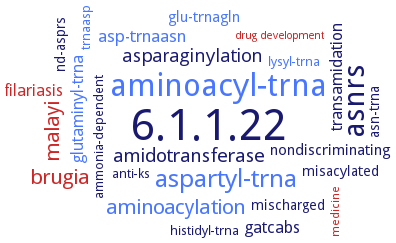6.1.1.22: asparagine-tRNA ligase
This is an abbreviated version!
For detailed information about asparagine-tRNA ligase, go to the full flat file.

Word Map on EC 6.1.1.22 
-
6.1.1.22
-
aminoacyl-trna
-
asnrs
-
aspartyl-trna
-
malayi
-
brugia
-
aminoacylation
-
amidotransferase
-
asparaginylation
-
asp-trnaasn
-
glutaminyl-trna
-
gatcabs
-
filariasis
-
transamidation
-
nondiscriminating
-
glu-trnagln
-
mischarged
-
misacylated
-
asn-trna
-
nd-asprs
-
ammonia-dependent
-
anti-ks
-
lysyl-trna
-
trnaasp
-
histidyl-trna
-
medicine
-
drug development
- 6.1.1.22
- aminoacyl-trna
- asnrs
- aspartyl-trna
- malayi
- brugia
- aminoacylation
-
amidotransferase
-
asparaginylation
- asp-trnaasn
- glutaminyl-trna
- gatcabs
- filariasis
-
transamidation
-
nondiscriminating
- glu-trnagln
-
mischarged
-
misacylated
-
asn-trna
- nd-asprs
-
ammonia-dependent
-
anti-ks
- lysyl-trna
- trnaasp
-
histidyl-trna
- medicine
- drug development
Reaction
Synonyms
AS-AR, AsnRS, Asparagine synthetase A, Asparagine translase, asparagine tRNA synthetase, Asparagine--tRNA ligase, Asparaginyl transfer ribonucleic acid synthetase, Asparaginyl transfer RNA synthetase, asparaginyl tRNA synthetase, Asparaginyl-transfer ribonucleate synthetase, asparaginyl-transfer RNA synthetase, Asparaginyl-tRNA synthetase, Asparagyl-transfer RNA synthetase, class IIb asparaginyl-tRNA synthetase, More, NARS, NARS2, NRS, Potentially protective 63 kDa antigen, PYRAB02460, Synthetase, asparaginyl-transfer ribonucleate
ECTree
Advanced search results
Engineering
Engineering on EC 6.1.1.22 - asparagine-tRNA ligase
Please wait a moment until all data is loaded. This message will disappear when all data is loaded.
L65A
-
the mutant strain lys65a produces an enzyme with greater temperature lability in vitro, a higher temperature-independent Km for Asn, and a lower temperature-dependent catalytic capacity than the enzyme from the wild-type strain
P231L
-
temperature-sensitive mutant HO202, P231L replacement leads to a change in aminoacylation activity. 50fold increased Km for Asn compared to the wild-type, and 8fold increase for ATP in ATP-diphosphate exchange. Significantly increased Km-values for Asn and ATP in aminoacylation. Pro-231 does not seem to be implicated directly in substrate binding. Instead it seems to have a structural role on the positioning of the loop formed by the motif 2
Y426F
-
wild-type and mutant enzymes Y426F and Y426S. Y426S replacement leads to a 15fold increase in Km for ATP, while all the other kinetic parameters remain unchanged. Y426F replacement does not affect the kinetic behaviour of the enzyme
Y426S
-
wild-type and mutant enzymes Y426F and Y426S. Y426S replacement leads to a 15fold increase in Km for ATP, while all the other kinetic parameters remain unchanged. Y426F replacement does not affect the kinetic behaviour of the enzyme
N381S
mutation decreases NARS2 protein levels in patient fibroblasts and also disrupts dimerization of NARS2
Q274H
the mutation leads to defective oxidative phosphorylation activity involving complex I and IV
V213F
Y323*/N381S
mutation results in mitochondrial respiratory chain deficiency and Leigh syndrome, a neurodegenerative disease characterized by symmetric, bilateral lesions in the basal ganglia, thalamus, and brain stem
Y323DEL/N381S
the mutations result in mitochondrial respiratory chain deficiency and Leigh syndrome which is a neurodegenerative disease characterized by symmetric, bilateral lesions in the basal ganglia, thalamus, and brain stem
R83A
site-directed mutagenesis, active site amino acid binding mutant, structure analysis in comparison to the wild-type enzyme
additional information
mutation is the underlying cause of nonsyndromic hearing loss, mutation has no effect on oligomerization
-
treatment of HEK-293T cells expressing CXCR2 with the filarial AsnRS, recombinantly expressed in Escherichia coli, parasite AsnRS is chemotactic for human neutrophils and eosinophils, blocks CXCL1-induced calcium flux, and induces mitogen-activated protein kinase, overview
additional information
-
the recombinant human enzyme does not induce leukocyte chemotaxis of HEK-293T cells transfected with G-protein-coupled receptors CXCR1 or CXCR2, overview
additional information
homozygous missense mutation c.822G>C affects the 3 splice site of exon 7, leading to skipping of the whole exon 7 and a part of exon 8 in the NARS2 mRNA. Upon expression in fibroblasts a specific decrease in the amount of charged mt-tRNAAsn is found. Mutation was found in in two siblings born to consanguineous parents, one presenting with mild intellectual disability and epilepsy in childhood, whereas the other had severe myopathy
additional information
-
downregulation of NARS by siRNA in MC3T3-E1 and primary mouse calvarial cells


 results (
results ( results (
results ( top
top






